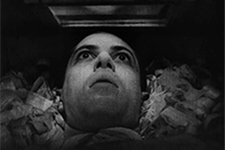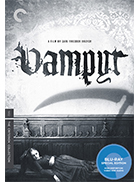Vampyr
|  Shadows are inherently creepy—unnerving, you might say. While taking the form and shape of that which casts them, they have no actual presence or substance, hence they are both real and unreal. In a sense, they are absence incarnate in that they exist by denying the presence of light, thus they are defined by what they are not, rather than what they are. There is no life to them, yet they often signal the presence of something living, which is why a shadow moving independently of its source is perhaps the most uncanny image imaginable. This idea seems to be the very foundation of Carl Theodor Dreyer’s Vampyr (Vampyr: Der Traum des Allan Grey), a masterfully evocative and unsettling horror film that failed to find the audience it deserved in the early 1930s because its challenging tone and unorthodox structure was upstaged by Tod Browning’s more conventional approach to the genre in Dracula (1931). The irony is that Dreyer had set out to make what, in his mind, would be a “commercial film,” but his unique artistic sensibilities and spiritual leanings virtually ensured that it would be anything but. At the time Vampyr was made, the “horror film” was still in its nascent stage, a barely defined category that included only a handful of films (that would change, of course, in the wake of Universal’s extremely popular horror films of the 1930s and their rash of imitators). In fact, prior to Vampyr, the vampire as we know it had graced the silver screen only once in F.W. Murnau’s expressionistic Nosferatu (1922). While Browning’s version of Dracula would beat Vampyr to theaters and thus predate it in the popular imagination, Dreyer’s film was actually the first to go into production. Although the credits state that Vampyr is based on In a Glass Darkly, a collection of five novellas by the Irish writer Sheridan Le Fanu, it draws only loosely on two of the stories, most notably “Carmilla,” a tale of a beautiful female vampire who feeds on young female victims (do I even need to mention the lesbian subtext?). Dreyer and his coscreenwriter Christen Jul also seem to have drawn at least partially from Bram Stoker’s 1897 novel Dracula, as well as from all kinds of folk tales and occult stories, which gives their film an authentic, organic tone that makes it feel ancient, even though it is set in the (then) modern world. The nominal hero of the story is Allan Grey (Nicolas de Gunzburg, the film’s financier, acting under the name Julian West), who is described in an opening title card as a young man who has “immersed himself in the study of devil worship and vampires” and, as a result, has become “a dreamer for whom the line between the real and the supernatural became blurred.” However, Dreyer appears to be only vaguely interested in Grey as a character, which is underscored by the fact that his role as the protagonist and primary mover of the narrative is usurped halfway through the film by an old servant (Albert Bras). Rather, the spectral atmosphere, which feels as if it were ripped directly from the subconscious, is the film’s main character. Dreyer weaves the film’s tone out of actual locations (a deserted chateau, a decrepit factory, various woods and fields) and a brooding, persistent visual sensibility that makes startling use of tracking shots, discontinuous editing, reverse photography, and framing that allows characters to enter and leave the screen at unexpected points. Even though it is technically a synchronous sound film, shot with a variable density soundtrack, from an aesthetic standpoint, Vampyr is a perfect summation of the pinnacle to which silent film art had reached by the end of the 1920s. Dreyer had already proved his mastery of the form with The Passion of Joan of Arc (1928), and it is not surprising that he shot Vampyr like a silent film, with only minimal bits of dialogue that he ambitiously shot in three different language (German, French, and English) to avoid the use of subtitles in international distribution. Vampyr’s silent-film heritage can be seen in everything from the fluidity of the camera movement (almost impossible in the early 1930s with bulky sound-on-location equipment), to the use of lengthy intertitles to explain story points and later a heavy reliance on a book of vampire lore to fill in the blanks about the nature of the film’s supernatural villain. The supernatural element in Vampyr pervades its every frame, which is precisely what makes it such an evocative experience and may also be why audiences initially rejected it as difficult and confusing. While there is a vampire in the film, a hulking old crone named Marguerite Chopin (Henriette Gérard) who is aided and abetted by a frazzled-looking village doctor (Jan Hieronimko), Dreyer does not limit the film’s supernatural suggestiveness to her activities (in fact, there is technically only one vampire “attack” in the whole film, which is staged as a beautifully horrific variation on Henry Fuseli’s painting The Nightmare). Rather, Dreyer draws from all kinds of supernatural lore, giving us shadowy figures who drift throughout the film; strange, inexplicable characters, including a man with a large scythe, who enter and leave the story without explanation; and a constant merging of waking reality and dream states, which culminates in the most famous sequence in the film where Allan Gray dreams that he is paralyzed and encased in a coffin with a glass window—as unnerving a portrait of living death as has ever been committed to celluloid. The word “inexplicable” best defines most of Vampyr, which appears to both a conscious decision of Dreyer’s to forsake easy explanation in favor of provoking the audience to decide for themselves what is real and what is unreal, as well as the unfortunate result of editing the film after its disastrous first screening. When done poorly, the inexplicable can result in Ed Wood-style camp, where the narrative gaps and logical pitfalls are clearly the product of general inanity. However, when it is done with style and purpose—a willful refusal to give everything a tidy explanation and make all the ends fit together—it can result in a truly memorable and frightening experience. Interestingly, just after viewing Vampyr, I happened to read a column by novelist Stephen King about why so many big-budget, big-studio horror movies don’t work, and part of his assessment is as perfect a summation of Vampyr as I can imagine: “[N]ightmares exist outside of logic, and there’s little fun to be had in explanations; they’re antithetical to the poetry of fear.” So, even though I don’t know why the shadows move the way they do in Vampyr, I feel the uncanny effect they have on me, and that’s all I need.
Copyright © 2017 James Kendrick Thoughts? E-mail James Kendrick All images copyright © The Criterion Collection | |||||||||||||||||||||||||||||||
Overall Rating: 


 (4)
(4)


